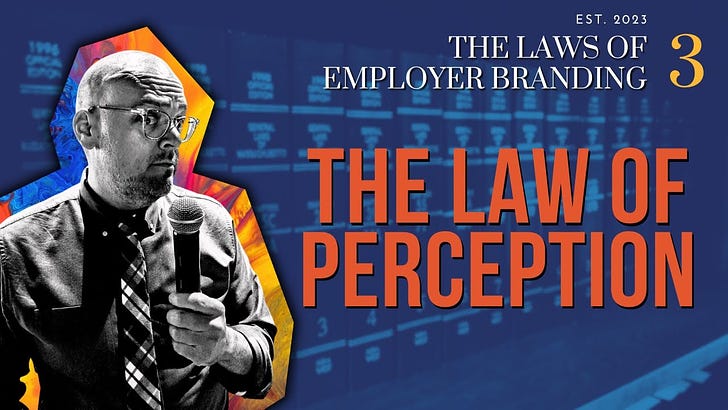Want some free employer brand consulting? Reply to this email and we’ll set up a sessions where I’ll answer any three questions you have for free. The only catch? We’ll record it and it might turn into something! Just hit reply if you’re interested.
+++++
Read the first half of this law in Monday’s edition.
Why this works
The employer brand defines and describes to people on the outside how the company works and what it rewards. It sets the frame around which people set their expectations about what the experience will be like and the likelihood that they will be satisfied.
The power of this becomes obvious when you see it through the flywheel. Let’s say you offer autonomy to candidates. Candidates who want and value autonomy are more likely to apply and get hired, thus increasing the number of people at work who value autonomy, which in turn attracts more people who value autonomy. The employer brand creates its own self-fulfilling prophecy because it is the thinking around the impression a company makes to a candidate.
Where this falls apart
One of the core frictions in our work is balancing what we see and hear from staff every day and the company that leadership thinks it is (or wants it to be). So when the brand is emanating from every part of the company and impacting every part of the company, a lack of alignment with what leadership intentions and aspirations becomes obvious. The net result is a fragmented sense of what it’s like to work there, thereby hamstringing the brand's ability to help the company.
The other major obstacle here is the company’s unwillingness to see how the brand, which encapsulates the work experience, values and culture (among other things) being the kind of “operating instructions” for working at the company. Many teams see themselves as special or independent of what “the rest of the company” thinks (see developers in the early days of Facebook or traders in an investment firm).
Examples
For companies where the people are the most obviously differentiating value, this law is crystal clear. Think of an airline. Every airline has to fly through the same cities and airports. Every airline has to cover the same geography through the same airspace. They all fly the same planes. The biggest difference between a Delta and a United are the people who work there: the people staffing the gate handling onboardings and delays, the flight attendants providing service, the baggage handlers making sure your luggage gets where it needs to go in one piece, and the pilots providing committed to safely and speed.
In companies like these, it doesn’t take much at all to see the difference between a strong and clear brand and one which is all “pretty words and pictures” with nothing underpinning it.
This is also true for consulting firms, where a McKinsey or EY might have an operating philosophy or process, but in the end, it's the people who create connections, build solutions and serve the customer. Where it pretty much doesn’t matter who is staffing the grill at McDonald’s, the output is meant to be fool-proof and the same whether you’re eating in Hoboken or Hollywood, your only interaction with a consultant firm come through the consultant assigned to the project. Thus, the brand has an outsized impact on who is attracted to the company and how the firm is ultimately seen by customers.
+++++
Reminder: I’m making short videos to dive into these laws. I’ve got three out already:
***This Newsletter Contains No ChatGPT***
-James Ellis [LinkedIn] [Website]
###




